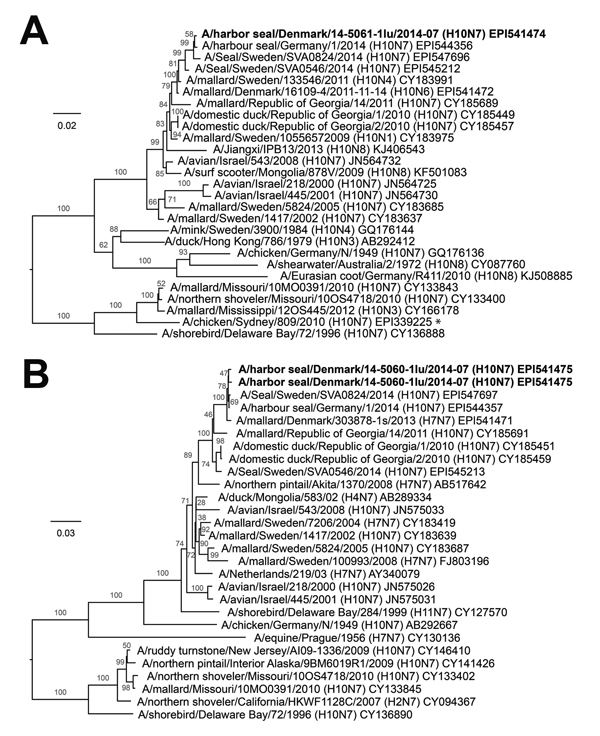Volume 21, Number 4—April 2015
Dispatch
Influenza A(H10N7) Virus in Dead Harbor Seals, Denmark
Figure 2

Figure 2. Phylogenetic trees of selected avian influenza A virus sequences. Boldface indicates sequences identified from harbor seals in Denmark during 2014. A) H10 avian influenza A virus sequences. The asterisk denotes the H10N7 subtype that also caused disease in humans (9). B) N7 avian influenza A virus sequences. Sequences were aligned with CLC Main Workbench version 7.02 (CLC bio, Aarhus, Denmark) by using the MUSCLE algorithm, and phylogenetic trees were constructed by using the neighbor-joining method with 1,000 bootstrap replicates. Only bootstrap values >75% are shown. Scale bars indicate mutations per site.
References
- Reperant LA, Rimmelzwaan GF, Kuiken T. Avian influenza viruses in mammals. Rev Sci Tech. 2009;28:137–59 .PubMedGoogle Scholar
- Harder TC, Siebert U, Wohlsein P, Vahlenkamp T. Influenza A virus infections in marine mammals and terrestrial carnivores. Berl Munch Tierarztl Wochenschr. 2013;126:500–8 .PubMedGoogle Scholar
- White VC. A review of influenza viruses in seals and the implications for public health. US Army Med Dep J. 2013:45–50. PMID: 23277445
- Goldstein T, Mena I, Anthony SJ, Medina R, Robinson PW, Greig DJ, Pandemic H1N1 influenza isolated from free-ranging northern elephant seals in 2010 off the central California coast. PLoS ONE. 2013;8:e62259. DOIPubMedGoogle Scholar
- Zohari S, Neimanis A, Härkönen T, Moraeus C, Valarcher JF. Avian influenza A (H10N7) virus involvement in mass mortality of harbour seals (Phoca vitulina) in Sweden, March through October 2014. Euro Surveill. 2014;19:20967 .PubMedGoogle Scholar
- MacDonald DW, Gilcheust EW. Dipetalonema spirocauda and Pseudomonas aeruginosa infection in a harbor seal (Phoca vitulina). Can Vet J. 1969;10:220–1 .PubMedGoogle Scholar
- Trebbien R, Bragstad K, Larsen LE, Nielsen J, Bøtner A, Heegaard PMH, Genetic and biological characterisation of an avian-like H1N2 swine influenza virus generated by reassortment of circulating avian-like H1N1 and H3N2 subtypes in Denmark. Virol J. 2013;10:290. DOIPubMedGoogle Scholar
- Barrett T, Visser IKG, Mamaev L, Goatley L, van Bressem MF, Osterhaus ADME. Dolphin and porpoise morbilliviruses are genetically distinct from phocine distemper virus. Virology. 1993;193:1010–2. DOIPubMedGoogle Scholar
- Arzey GG, Kirkland PD, Arzey KE, Frost M, Maywood P, Canaty S, Influenza virus A (H10N7) in chickens and poultry abbattoir workers, Australia. Emerg Infect Dis. 2012;18:814–6. DOIPubMedGoogle Scholar
- Zohari S, Metreveli G, Kiss I, Belák S, Berg M. Full genome comparison and characterization of avian H10 viruses with different pathogenicity in mink (Mustela vison) reveals genetic and functional differences in the non-structural gene. Virol J. 2010;7:145. DOIPubMedGoogle Scholar
- Callan RJ, Early G, Kida H, Hinshaw VS. The appearance of H3 influenza viruses in seals. J Gen Virol. 1995;76:199–203. DOIPubMedGoogle Scholar
- Hinshaw VS, Bean WJ, Webster RG, Rehg JE, Fiorelli P, Early G, Are seals frequently infected with avian influenza viruses? J Virol. 1984;51:863–5 .PubMedGoogle Scholar
- Lang G, Gagnon A, Geraci JR. Isolation of an influenza A virus from seals. Arch Virol. 1981;68:189–95. DOIPubMedGoogle Scholar
- Webster RG, Hinshaw VS, Bean WJ, van Wyke KL, Geraci JR, St Aubin DJ, Characterization of an influenza A virus from seals. Virology. 1981;113:712–24. DOIPubMedGoogle Scholar
- Wood GW, Banks J, Strong I, Parsons G, Alexander DJ. An avian influenza virus of H10 subtype that is highly pathogenic for chickens, but lacks multiple basic amino acids at the haemagglutinin cleavage site. Avian Pathol. 1996;25:799–806. DOIPubMedGoogle Scholar
Page created: March 17, 2015
Page updated: March 17, 2015
Page reviewed: March 17, 2015
The conclusions, findings, and opinions expressed by authors contributing to this journal do not necessarily reflect the official position of the U.S. Department of Health and Human Services, the Public Health Service, the Centers for Disease Control and Prevention, or the authors' affiliated institutions. Use of trade names is for identification only and does not imply endorsement by any of the groups named above.